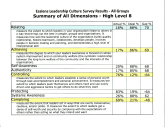In an internal Esalen email dated January 21, 2010, Esalen CEO Tricia McEntee wrote:
In the interest of building a relationship of honesty, integrity, and trust, among organization employees, [any corporate survey] results should be communicated effectively by a unbiased professional and acted upon by the organization.
In the Spring of 2011, Esalen conducted a Leadership Culture Survey, but failed to convey the results or act upon them. The results have been available for viewing, but not copying, and only for those willing to ask terminatrix Jan Sinclair to briefly unveil the secret papers in a private meeting.
After a full year of the survey being suppressed in this way, The Nine are proud to present the results for public viewing and discussion. As unbiased professionals, we trust that Ms. McEntee will approve.
The lowest score on the chart is for the “interpersonal intelligence” of its leadership — an area where the Institute is chartered to be a center of excellence and teaching.
Meanwhile the data shows an almost perfect score in the area of “customer focus” in the business as a whole — an area where Esalen leadership has steadfastly insisted there is a deadly deficit, choosing to turn the Institute’s culture upside down in the name of solving this clearly imaginary problem.
These results, and the reasons for their suppression by current leadership, speak for themselves. The respect and deference granted to these “leaders” by the community at the recent Community-Board Meeting remains a perplexing disappointment.
UPDATE: Our original leak appears below. More complete survey results are now here.

Leadership Culture Survey Results
Summary of All Dimensions

Leadership Culture Survey Results
Top 10 Sub-Categories

Leadership Culture Survey Results
Lowest 5 Sub-Categories


dear Essaleaks,
As the person who conducted this survey, I need to correct your assertion that it shows a ‘near perfect score’ on customer focus. This is an incorrect reading of the data. What it shows is that the Culture (you) assess your current focus at a level of 52%, while your desired focus is 60%, so yes, you are almost delivering the level of customer service that you would like. However, the bigger picture is that this data is conveyed as a percentile, based on all the other organistaions (for profit, and non-profit, educational institutions etc)And by scoring only 60% as an Ideal Customer Focus, rather than 100% you are clearly signalling that you are not as interested in customers as most other organisations are.
I’m sorry that you didn’t get access to the data in a timely manner. This was not anyone’s intention when I was working with the team there.
Best of luck
Vanda